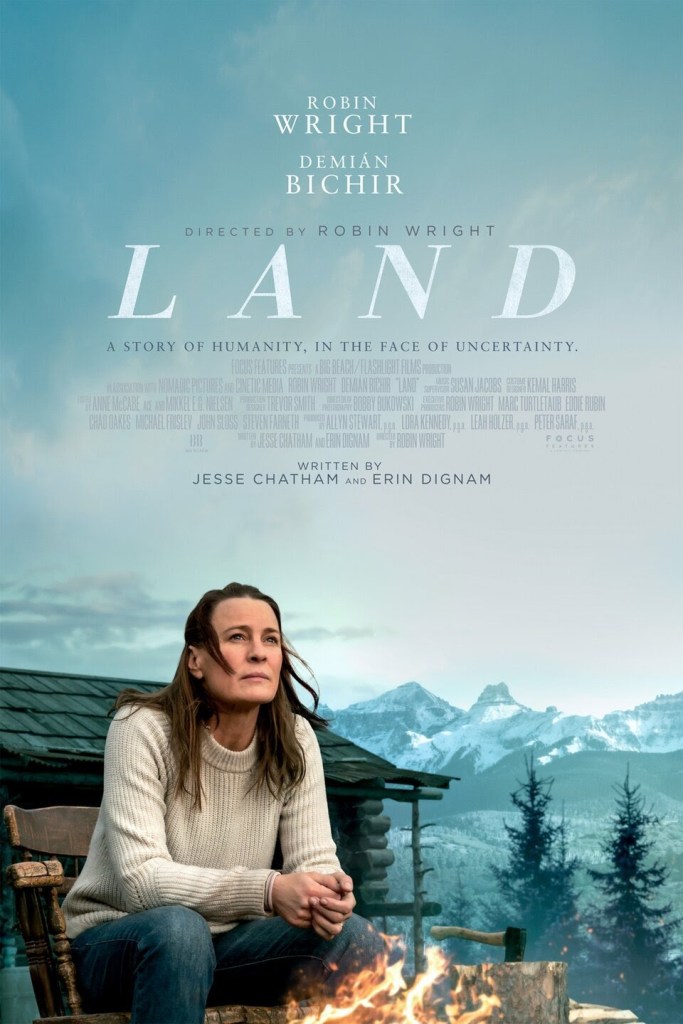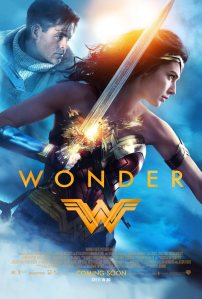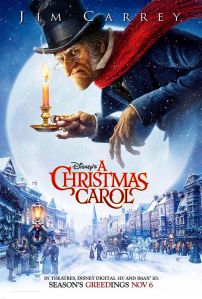A thoughtful exploration of PTSD, grief, and isolation that takes you on a journey that will ultimately lift your spirits and leave you with hope. Robin Wright’s directorial debut LAND is a breathtaking motion picture best experienced on the BIG SCREEN. And fortunately, it’s currently only available on the big screen. From the sweeping mountain landscapes to intimate character moments, this motion picture is an audacious yet simple story. Wright’s film is a punctilious, existential character study about the importance of connection even when isolation seems to be the only choice to work though (or avoid, as it were) traumatic, debilitating stress. Land an intelligent, emotionally moving work of cinematic art. So often character study films find themselves on the verge, if not intentionally, manipulating the audience; however, this film finds the balance in delivering the thoughtful moments and plot direction. That said, the third act does feel a bit rushed after the methodical first two acts. When actors transition to writer or director, there is historically a tendency to be self-indulgent, sometimes to the point of crafting one’s own Oscar or sizzle reel, in an effort to demonstrate the breadth of talent that they feel their previous directors or producers have hindered them from fully showcasing, but that is not the case with Wright’s LAND. While Wright is demonstrating that she can successfully direct a motion picture, she is making this film for any and everyone who has suffered a great loss or experienced a psychologically damaging trauma. With minimal dialogue, especially in the first act, Wright takes a page out of the Norma Desmond school of filmmaking, and relies upon the power of the eyes and nuance of body language to say everything. “I can say anything with my eyes,” –Norma Desmond (Sunset Boulevard).
When Edee (Robin Wright) cannot find solace in her therapist or sister following a tragedy, she buys an isolated home in the mountain wilderness of Wyoming, and completely disconnects from the outside world. “No phones, no lights, no motorcars, not a single luxury…,” you get the idea. Not fully prepared for the harshness of living on the frontier, she finds herself at the brink of death when a local hunter Miguel (Demian Bichir) and nurse Alawa (Sarah Dawn Pledge) come to her rescue. Although Edee is thankful for saving her life, she is resistent to any further help or company. Through her geographic and social isolation, Edee learns the value of human connection.
At its heart, LAND is a character-driven story about loss and grief so unimaginable that it drives one to the brink of death. And Wright does a brilliant job at visually communicating the immenseness of this pain through the use of placing the central character of Edee against the backdrop of the Rocky Mountain wilderness. When one experiences an intense psychological trauma, it’s almost as if the entire once-familiar landscape has radically changed, and has it in for you. Throughout the introductory scenes and even the first act as a whole, Edee displays great pain. But it’s not big and loud pain; it’s nuanced and understated, but no less powerful and moving, eliciting great empathy from the audience. The screenwriters strategically withhold the details about the trauma that led Edee to make her radical decision to escape to the wilderness to escape the pain of reality. However, we are given little crumbs of exposition through the effective use of brief flashbacks paired with intense plot beats. Through these brief flashbacks, we learn that Edee has a sister named Emma; but we also get glimpses of a man and boy (that we later learn is Edee’s lost husband and son). By the screenwriters keeping these cards close to their chest, the audience keeps the focus on Edee’s present journey, and it has the added benefit of driving up the suspense.
Up to the point of Edee’s near death experience due to hypothermia, the film has an incredibly somber tone with little to no hope in sight. But with the introduction of Miguel and Alawa, the film undergoes a tonal shift. Not only do these good Samaritans save Edee’s life, but Miguel becomes an unexpected companion, teacher, and eventual friend. Apprehensive to the idea of human company, Edee eventually finds value in the survival lessons that Miguel can teach her. Against her initial reaction to this new-found neighbor, she accepts Miguel’s offer but asks that he not tell her anything of the outside world. Edee learned early on that Miguel has his own trauma that he’s working through, and uses hunting and quiet times in the wilderness as his therapy. Watching these two interact with one another, softens the tone of the film even though the specter of Edee’s anger remains active beneath the surface. Still, we can tell that she is consistently processing her experience and reaction thereof as she learns to live off the land. Over the months the Edee is learning from Miguel, we witness that Edee is strong and capable, and isn’t allowing the loss of her family to leave her a victim. Rather than becoming a prisoner of or exploiting her suffering, she uses it as motivation. She turns her immense pain into something proactive and meaningful.
While shooting a film in such a breathtaking setting may provide temptation to capture the majestic beauty of the Wyoming Rockies to the extent that the film merely becomes a series of postcards that happen to contain some plotting and conflict, LAND never shifts focus from our central character. The environment in which she finds herself manifests an extension of the emotional turmoil. Despite the grand beauty of the setting, it never feels entirely safe. Danger looms around every corner, because it was successfully setup right from the very beginning. Much in the same way that the set and production design of a gothic romance or German expressionism film creatively manifest the emotional subtext and tone of the film, the mountainous landscape of LAND very much does the same. When we are internalizing trauma, whether it’s by intentional choice or subconsciously, the image we project may be positive and beautiful, not unlike the mountains that surround Edee’s shack. But that shack represents the turmoil that has taken up residence within our mind.
For all the avant-garde elements of Wright’s LAND, she directed an accessible character-study motion picture that most audiences can appreciate and understand. All the while, Wright doesn’t have to hold our hands along the treacherous pathways. While the plot is simple, this film provides a great opportunity to have conversations about the affects of trauma, especially when it’s unimaginable. Whether you have found yourself in the depths of depression and self-imposed isolation as Edee or not, you will be able to connect to this relatable character because we have all lost someone dear to us (most recently, I lost my grandmother). Perhaps you have chosen a different method for coping with your grief, but this is how Edee chose to deal with hers. It’s a journey to which we can relate, as so often we don’t really know what to do with our anger following tragedy. Sometimes we too may feel that we want to escape from it all, but we eventually learn that we need human connection in order to survive.
This is a motion picture truly best experienced on the BIG SCREEN at THE CINEMA. Cinemas are hard at work to create a safe environment for you. I am a regular at the Universal Cinemark, and have never felt unsafe.
Ryan teaches screenwriting and film studies at the University of Tampa. If you like this article, check out the others and FOLLOW this blog! Interested in Ryan making a guest appearance on your podcast or contributing to your website? Send him a DM on Twitter or email him at RLTerry1@gmail.com! If you’re ever in Tampa or Orlando, feel free to catch a movie with or meet him in the theme parks!
Follow him on Twitter: RLTerry1





